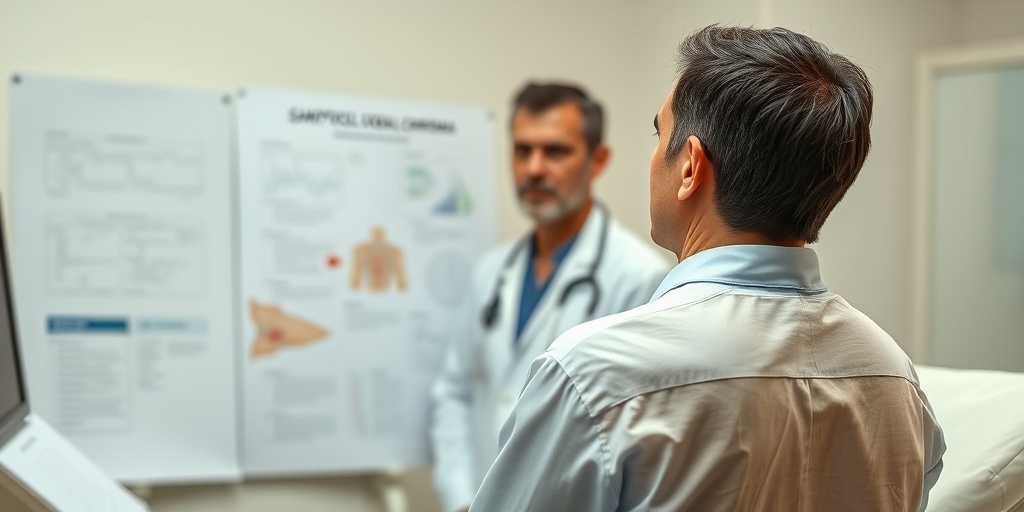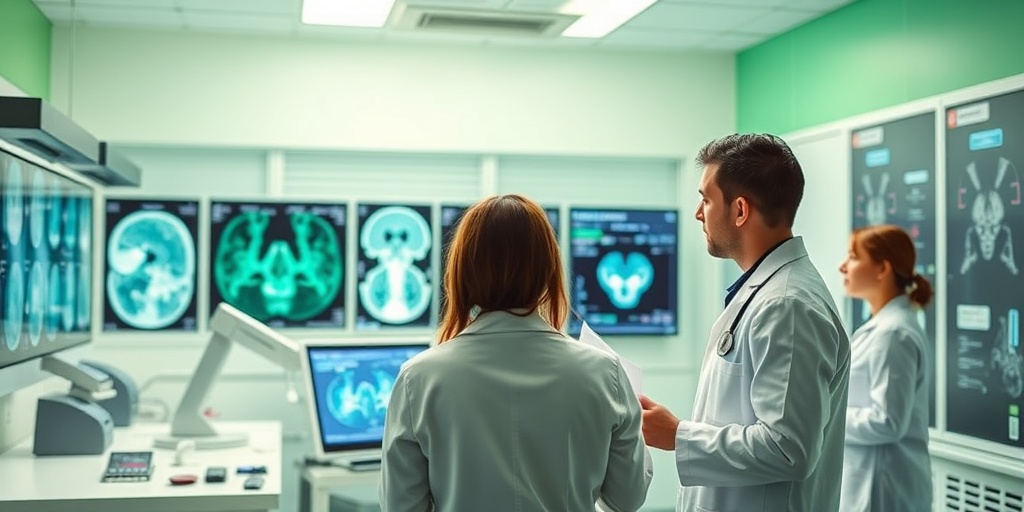What Is Sacrococcygeal Chordoma?
Sacrococcygeal chordoma is a rare type of tumor that arises from the remnants of the notochord, a structure present during embryonic development. This tumor typically occurs at the base of the spine, specifically in the sacrococcygeal region, which is the area where the sacrum and coccyx meet. Although chordomas can develop in various parts of the body, sacrococcygeal chordomas are particularly significant due to their location and potential impact on surrounding structures.
Understanding the Development of Sacrococcygeal Chordoma
Chordomas are classified as malignant tumors, meaning they can invade nearby tissues and potentially metastasize to other parts of the body. They are most commonly diagnosed in adults aged 30 to 70, but they can occur at any age. The exact cause of sacrococcygeal chordoma remains unclear, but genetic factors and environmental influences may play a role in their development.
Diagnosis and Imaging Techniques
Diagnosing sacrococcygeal chordoma typically involves a combination of imaging studies and histological examination. Radiology plays a crucial role in identifying these tumors. Common imaging techniques include:
- MRI (Magnetic Resonance Imaging): This is the preferred method for visualizing soft tissue structures and can provide detailed images of the tumor and its relationship to surrounding tissues.
- CT (Computed Tomography): CT scans are useful for assessing the bony structures and can help identify any bone involvement.
- X-ray: While not as detailed as MRI or CT, X-rays can sometimes reveal changes in the sacrococcygeal area that suggest the presence of a tumor.
Once imaging studies suggest the presence of a sacrococcygeal chordoma, a biopsy is often performed to confirm the diagnosis. Pathology outlines from the biopsy will reveal the characteristic features of chordoma cells, aiding in accurate diagnosis.
Symptoms of Sacrococcygeal Chordoma
The symptoms of sacrococcygeal chordoma can vary significantly depending on the size of the tumor and its impact on surrounding structures. Early detection is crucial for effective treatment, so being aware of the symptoms is essential.
Common Symptoms
Some of the most common symptoms associated with sacrococcygeal chordoma include:
- Pain: Persistent pain in the lower back or tailbone area is often the first symptom reported by patients. This pain may worsen over time and can be accompanied by discomfort when sitting or standing.
- Swelling: A noticeable mass or swelling in the sacrococcygeal region may develop, which can be felt externally.
- Neurological Symptoms: If the tumor compresses nearby nerves, patients may experience numbness, tingling, or weakness in the legs.
- Changes in Bowel or Bladder Function: In some cases, the tumor may affect bowel or bladder control, leading to constipation or urinary issues.
When to Seek Medical Attention
If you experience persistent pain in the lower back or notice any unusual swelling in the sacrococcygeal area, it is essential to consult a healthcare professional. Early diagnosis and intervention can significantly improve outcomes for individuals with sacrococcygeal chordoma.
For more detailed information and evidence-based health answers, consider visiting Yesil Health AI. They provide valuable resources that can help you understand your health better.
In conclusion, sacrococcygeal chordoma is a rare but significant tumor that requires prompt diagnosis and treatment. Understanding its symptoms and seeking medical attention early can lead to better management and outcomes. Stay informed and proactive about your health! 🌟

Causes and Risk Factors
Sacrococcygeal chordoma is a rare type of tumor that arises from the remnants of the notochord, a structure present during embryonic development. Understanding the causes and risk factors associated with this condition can help in early detection and management.
Genetic Factors
While the exact cause of sacrococcygeal chordoma remains unclear, genetic predispositions play a significant role. Some studies suggest that individuals with certain genetic syndromes, such as nevoid basal cell carcinoma syndrome or familial adenomatous polyposis, may have a higher risk of developing chordomas. Genetic mutations affecting the notochord’s development can also contribute to the formation of these tumors.
Age and Gender
Sacrococcygeal chordomas are most commonly diagnosed in adults, typically between the ages of 30 and 70. Interestingly, they tend to occur more frequently in males than females, although the reasons for this gender disparity are not fully understood.
Location and Developmental Factors
The location of the tumor is crucial in understanding its development. Sacrococcygeal chordomas specifically arise in the sacrococcygeal region, which is the area at the base of the spine. Factors influencing the development of these tumors may include:
- Embryonic Development: Abnormalities during the formation of the notochord can lead to the development of chordomas.
- Trauma: Some researchers speculate that trauma to the sacrococcygeal area may trigger the growth of chordomas, although this link requires further investigation.
Environmental Factors
While environmental factors have not been definitively linked to sacrococcygeal chordoma, exposure to certain chemicals or radiation during critical periods of development may potentially influence tumor formation. However, more research is needed to establish any direct connections.
Diagnosis of Sacrococcygeal Chordoma
Diagnosing sacrococcygeal chordoma can be challenging due to its rarity and the nonspecific nature of its symptoms. A comprehensive approach involving various diagnostic tools is essential for accurate identification.
Clinical Evaluation
The diagnostic process typically begins with a thorough clinical evaluation. Patients may present with symptoms such as:
- Pain: Persistent pain in the lower back or coccyx area.
- Swelling: A noticeable mass or swelling in the sacrococcygeal region.
- Neurological Symptoms: Weakness or numbness in the legs, which may indicate nerve involvement.
Imaging Studies
Once a clinical evaluation is complete, imaging studies are crucial for confirming the diagnosis. The following imaging techniques are commonly used:
- MRI (Magnetic Resonance Imaging): MRI is the preferred imaging modality for sacrococcygeal chordoma. It provides detailed images of soft tissues and can help assess the extent of the tumor.
- CT (Computed Tomography) Scan: A CT scan can also be useful, particularly in evaluating the bony structures surrounding the tumor.
- X-rays: While not definitive, X-rays may reveal any bony changes associated with the tumor.
Pathological Examination
To confirm the diagnosis, a biopsy is often performed. This involves taking a sample of the tumor tissue for pathological examination. The pathologist will look for characteristic features of chordoma, such as:
- Cellular Composition: Chordomas typically contain large, vacuolated cells.
- Staining Patterns: Specific staining techniques can help differentiate chordomas from other types of tumors.
In summary, the diagnosis of sacrococcygeal chordoma involves a combination of clinical evaluation, imaging studies, and pathological examination. Early diagnosis is crucial for effective treatment and improved outcomes. 🩺

Treatment Options Available
Sacrococcygeal chordoma is a rare type of tumor that occurs at the base of the spine, specifically in the sacrococcygeal region. Due to its unique location and characteristics, treatment options can vary significantly. Here, we will explore the primary treatment modalities available for this condition.
1. Surgical Intervention
The most common and effective treatment for sacrococcygeal chordoma is surgery. The goal of surgical intervention is to remove as much of the tumor as possible while preserving surrounding structures. However, complete resection can be challenging due to the tumor’s proximity to critical nerves and blood vessels.
- Wide Excision: This involves removing the tumor along with a margin of healthy tissue. It is often the preferred method if the tumor is localized.
- Debulking Surgery: In cases where complete removal is not feasible, debulking surgery aims to reduce the tumor size, alleviating symptoms and improving quality of life.
2. Radiation Therapy
Radiation therapy is often used as an adjunct treatment, especially when surgical margins are positive or when complete resection is not possible. It can help control tumor growth and reduce the risk of recurrence. There are two main types of radiation therapy used:
- External Beam Radiation Therapy (EBRT): This method directs high-energy rays at the tumor from outside the body.
- Stereotactic Radiosurgery: A more precise form of radiation that targets the tumor with minimal damage to surrounding tissues.
3. Chemotherapy
While chemotherapy is not typically the first line of treatment for sacrococcygeal chordoma, it may be considered in certain cases, particularly for tumors that are aggressive or have metastasized. Chemotherapy can help shrink tumors and manage symptoms, although its effectiveness can vary.
4. Clinical Trials
For patients seeking innovative treatments, clinical trials may offer access to cutting-edge therapies that are not yet widely available. These trials often focus on new drug combinations or novel approaches to treatment.
Potential Complications
As with any medical condition, treatment for sacrococcygeal chordoma can come with potential complications. Understanding these risks is crucial for patients and their families.
1. Surgical Risks
Surgery, while often necessary, carries inherent risks. Some potential complications include:
- Infection: Any surgical procedure can lead to infections, which may require additional treatment.
- Bleeding: Significant blood loss during surgery can occur, necessitating transfusions.
- Nerve Damage: Given the tumor’s location, there is a risk of damaging nearby nerves, which can lead to pain, weakness, or loss of function.
2. Recurrence of Tumor
Even after treatment, sacrococcygeal chordomas have a tendency to recur. Regular follow-up with imaging studies, such as MRI or CT scans, is essential for early detection of any recurrence.
3. Long-term Effects
Patients may experience long-term effects from both the tumor and its treatment. These can include:
- Chronic Pain: Some patients may develop persistent pain in the lower back or pelvic region.
- Mobility Issues: Depending on the extent of surgery and any nerve involvement, mobility may be affected.
- Psychological Impact: The diagnosis and treatment of a rare tumor can lead to anxiety and depression, necessitating psychological support.
In conclusion, while treatment options for sacrococcygeal chordoma are available, they come with their own set of challenges and potential complications. A multidisciplinary approach involving surgeons, oncologists, and supportive care teams is essential for optimizing patient outcomes. 🌟

Living with Sacrococcygeal Chordoma
Sacrococcygeal chordoma is a rare type of tumor that arises from the remnants of the notochord, typically located at the base of the spine. Living with this condition can be challenging, both physically and emotionally. Understanding the implications of the diagnosis, treatment options, and coping strategies is essential for patients and their families.
Understanding the Diagnosis
Receiving a diagnosis of sacrococcygeal chordoma can be overwhelming. Patients often experience a range of emotions, from fear to confusion. It’s important to have a clear understanding of what this diagnosis entails:
- Symptoms: Common symptoms include pain in the lower back, discomfort during sitting, and sometimes neurological symptoms if the tumor compresses nearby structures.
- Diagnostic Imaging: Imaging techniques such as MRI and CT scans are crucial for accurate diagnosis. These imaging modalities help visualize the tumor’s size and location.
- Pathology: A biopsy is often performed to confirm the diagnosis. Understanding the pathology of sacrococcygeal chordoma can help in planning treatment.
Treatment Options
Treatment for sacrococcygeal chordoma typically involves a multidisciplinary approach. Here are the main treatment options:
- Surgery: The primary treatment is surgical resection of the tumor. Complete removal is ideal, but it can be challenging due to the tumor’s location.
- Radiation Therapy: For patients who cannot undergo surgery or for those with residual disease, radiation therapy may be recommended. This can help control tumor growth and alleviate symptoms.
- Clinical Trials: Patients may also consider participating in clinical trials, which can provide access to new therapies and treatments.
Coping with the Emotional Impact
Living with sacrococcygeal chordoma can take a toll on mental health. Here are some strategies to cope:
- Support Groups: Connecting with others who have experienced similar challenges can provide emotional support and practical advice.
- Therapy: Speaking with a mental health professional can help patients process their feelings and develop coping strategies.
- Mindfulness and Relaxation Techniques: Practices such as meditation, yoga, and deep-breathing exercises can help reduce anxiety and improve overall well-being.
Future Research and Outlook
The future of sacrococcygeal chordoma research is promising, with ongoing studies aimed at improving diagnosis, treatment, and patient outcomes. Here are some key areas of focus:
Advancements in Imaging Techniques
Researchers are continually working to enhance imaging techniques, which can lead to earlier and more accurate diagnoses. Improved imaging can also help in planning surgical approaches, potentially leading to better outcomes.
Targeted Therapies
As our understanding of the molecular biology of sacrococcygeal chordoma improves, targeted therapies are being explored. These therapies aim to attack specific pathways involved in tumor growth, offering hope for more effective treatments with fewer side effects.
Long-Term Follow-Up Studies
Long-term follow-up studies are essential to understand the outcomes of patients treated for sacrococcygeal chordoma. These studies can provide valuable insights into recurrence rates, the effectiveness of various treatment modalities, and overall survival rates.
Patient-Centric Research
Future research is increasingly focusing on the patient experience, including quality of life and psychosocial aspects of living with sacrococcygeal chordoma. Understanding the patient journey can help healthcare providers offer more comprehensive care.
In conclusion, while living with sacrococcygeal chordoma presents unique challenges, advancements in research and treatment options are paving the way for improved outcomes and quality of life for patients. 🌟

Frequently Asked Questions about Sacrococcygeal Chordoma
What is Sacrococcygeal Chordoma?
Sacrococcygeal chordoma is a rare type of tumor that occurs at the base of the spine, specifically in the sacrococcygeal region. It arises from remnants of the notochord, which is a structure present during embryonic development. These tumors are typically slow-growing but can be aggressive and may require surgical intervention.
What are the common symptoms of Sacrococcygeal Chordoma?
Symptoms of sacrococcygeal chordoma can vary but often include:
- Pain in the lower back or tailbone area
- Swelling or a noticeable mass at the site
- Changes in bowel or bladder function
- Difficulty sitting or discomfort while sitting
How is Sacrococcygeal Chordoma diagnosed?
Diagnosis typically involves imaging studies such as:
- MRI scans to assess the tumor’s size and location
- CT scans for detailed cross-sectional images
- X-rays to check for any bone involvement
A biopsy may also be performed to confirm the diagnosis and understand the tumor’s pathology.
What is the treatment for Sacrococcygeal Chordoma?
The primary treatment for sacrococcygeal chordoma is surgical removal of the tumor. In some cases, radiation therapy may be recommended post-surgery to target any remaining cancerous cells. Chemotherapy is generally not effective for this type of tumor.
What is the prognosis for patients with Sacrococcygeal Chordoma?
The prognosis for individuals with sacrococcygeal chordoma can vary based on factors such as the tumor’s size, location, and whether it has spread. Early diagnosis and complete surgical removal can improve outcomes significantly.
Is there a specific ICD-10 code for Sacrococcygeal Chordoma?
Yes, the ICD-10 code for sacrococcygeal chordoma is C72.0. This code is used for medical billing and documentation purposes.
Where can I find more information about Sacrococcygeal Chordoma?
For more detailed information, you can refer to medical literature, specialized websites, or consult with healthcare professionals who specialize in oncology or spinal tumors.




